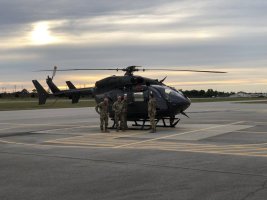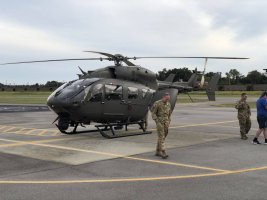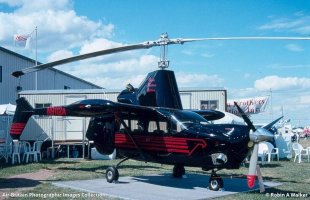I've yet to fly in a UH-72. The few Army Aviators I have spoken to that fly the UH-72 enjoy the aircraft.
Wayne
Amid the impressive collection of Army airpower on display at the 2009 Army Aviation Association of America convention in Nashville, Tennessee, it was the EADS …
www.shephardmedia.com
Pilots applaud the UH-72A Lakota
11th May 2009 - 15:00 GMT | by The Shephard News TeamRSS
Amid the impressive collection of Army airpower on display at the 2009 Army Aviation Association of America convention in Nashville, Tennessee, it was the EADS North America area of the exhibit hall that managed to steal the show.
The buzz started on May 4, the opening day of the show, with the announcement that EADS North America has assembled an industry team with Lockheed Martin and American Eurocopter to offer a new armed scout helicopter to the U.S. Army — the Armed Scout 645.
Like EADS’ UH-72A Lakota light utility helicopter, the Armed Scout 645 is based on the highly successful Eurocopter EC145 commercial airframe, and will be produced at American Eurocopter’s Columbus, Mississippi, facility.
The announcement was made to a mass of reporters in front of a representative Armed Scout 645 – a UH-72 sporting desert camouflage paint, an advanced sensor ball under its nose and racks of missiles and guns mounted along its flanks. The aircraft drew crowds throughout the show.
But it was just as busy across the aisle, where pilots and maintainers from the North Carolina National Guard were showing off one of the four new Lakotas they received at the end of last year, its dark green paint still mostly pristine.
Standing by his unit’s Lakota on the convention floor, Capt. Benny Collins answered questions all week about what the Lakota brings to his mission. Collins and his colleagues fly for a Security and Support Detachment with the North Carolina National Guard out of Morrisville, North Carolina, using their Lakotas for missions including homeland security, disaster relief, counter-drug operations, and soon search and rescue.
“One of the best things for us is the capability to carry six people in back,” or the equivalent amount of cargo, said Collins, whose unit was flying the OH-58A/C prior to delivery of the Lakotas. “Before, I could carry one passenger.”
The added weight capacity gives the unit greater mission flexibility, useful on operations where they are carrying large teams of emergency management first responders.
“To me the biggest difference is that it’s a true multi-mission aircraft,” said Chief Warrant Officer 4 Todd Woodard, another of the detachment’s pilots. “We can do hoist ops, carry passengers, carry cargo, do search and rescue, counter-drug, surveillance,” and potentially other missions, he said.
“The next big thing that stands out is the speed,” Collins said. Typical mission speeds in the Lakota range between 125 and 130 knots, he said, whereas pilots were limited to about 90 knots in his old platform.
That added speed translates into increased range, Collins said, noting that his available mission time has increased almost 50 percent, from two hours to two hours and 50 minutes, over greater distances.
Having a platform with superior payload, range and speed gives EADS North America an excellent starting point for an Armed Scout aircraft. “We’re confident that our team has a low-risk technical path to meet or exceed the performance requirements the Army outlined in the Sources Sought document,” said EADS North America Chief Operating Officer David R. Oliver, Jr.
Performance isn’t the only factor that Army pilots appreciate in the Lakota. According to Collins, aircrews are often fresher when they arrive on station on long missions, due to the reduced pilot workload that comes with the UH-72A’s advanced autopilot modes. In transit, pilots dial in a heading and altitude, then can fly hands off, freeing them to attend to other mission tasks in the cockpit.
“That cuts down on pilot fatigue significantly,” he said. “Six hours a day in this aircraft is nothing like flying six hours in the 58.”
Other factors also reduce fatigue, he said. “This aircraft doesn’t shake and rattle like other helicopters do.” Besides the OH-58, Collins has flown UH-1s and AH-64s for the National Guard.
The Lakota, like the EC145 platform that will form the basis of the Armed Scout 645, also offers controls and displays that ease a pilot’s tasks in a number of ways, explained American Eurocopter (AEC) pilot John Bourgeois. Bourgeois has more than 8,000 helicopter flight hours with the Army, Coast Guard and AEC, and now trains Army pilots on the Lakota at AEC’s headquarters in Grand Prairie, Texas.
The EC145 family of aircraft features digital flight controls that make the aircraft highly responsive without wrestling the controls. “The other aircraft our students are coming from have very heavy-handed flying controls,” Bourgeois said. “We have to teach them how to guide the aircraft, rather than manhandling the aircraft.”
Along with the dual, digital 3-axis autopilot, the Lakota provides automatic follow-up trim below 40 knots, meaning pilots only have to make minimal stick inputs to adjust aircraft attitude.
“It has dampening qualities you don’t have in other aircraft,”
Bourgeois said. “You have to let the autopilot do its thing, and then it’s got a lot smoother ride than other aircraft.”
The Lakota has a rigid rotor system that makes it both highly maneuverable and very stable in a hover, Bourgeois said. “I think both of those traits would enhance an aircraft’s suitability for the scout mission.”
The modern digital information displays are also as welcome change for pilots used to seeing only analog gauges.
“They fall in love with the glass cockpit,” Bourgeois said. “They like the central panel display system with the FLI,” or First Limit Indicator, which takes information from six different sensors and combines them on one display rather than six analog gauges.
“Once again, you’re reducing pilot workload,” said Bourgeois. “That combined with the hands-off capability to fly this coupled up to either GPS or to fly an [Instrument Landing System] approach frees up the pilot to do other mission functions in the cockpit.
“These features also make the Lakota an excellent platform for flying Instrument Flight Rules at night or in the clouds,” Bourgeois said.
“We had no IFR capability before,” Collins said. “Now we are fully IFR capable.”
The Lakota’s design doesn’t just offer advantages in the air, however, with mechanics lauding the aircraft’s ease of maintenance.
“Everything is much easier to access,” said Sgt. Kathy McQuay, a Lakota mechanic whose experience also includes working on AH-64 and OH-58 helicopters. “Everything is really easy to see.”
The Lakota’s clear and thorough troubleshooting procedures make it easier to diagnose issues than with any other aircraft McQuay has worked on before, she said. “I like that instead of just changing a part and hoping that it fixes the problem, I can pinpoint exactly where the problem is.” The UH-72A fleet has an operational availability rate higher than 90 percent.
The Armed Scout 645 would build on all of the capabilities and enhancements that Army crews appreciate in the UH-72A, EADS North America officials said.
EADS North America, as the prime contractor, has delivered 67 UH-72A Lakotas to the Army and Army National Guard since November 2006, with all aircraft supplied on or ahead of schedule and within budget.
The UH-72A is recognized as one of the most rapid aircraft introductions in Army aviation history. The growing fleet in Army service has passed the 10,000 flight-hour milestone, demonstrating mission performance and reliability in operations throughout the United States. To date, 128 Lakotas have been ordered by the Army, with plans to acquire a total of 345 UH-72As by 2016.





